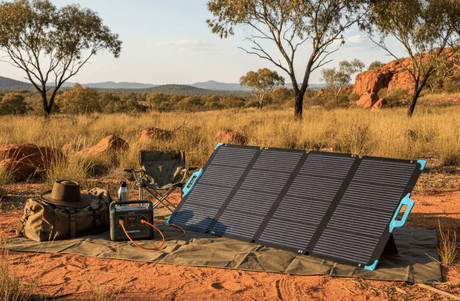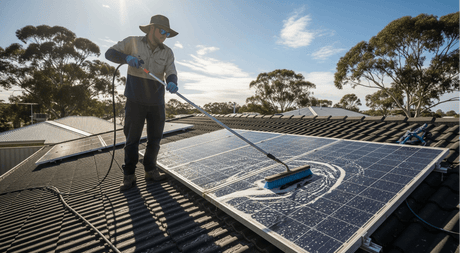Choosing the right solar power battery charger depends on several variables. Solar-powered battery chargers refer to a group of products that can fully charge your battery banks, and it’s essential to build a system that works together to ensure that you’re getting maximum output from your solar panels. We’ll outline the key specifications and considerations for creating a solar charging system that works for you.
How Do Solar Batteries Work?
Solar batteries are the storage component of a solar-powered energy system. There are four different kinds of batteries you can use in your system:
Lithium Iron Phosphate (LiFePO4)
Lithium batteries are the latest and greatest battery technology. They can handle rapid charging and discharging and work in a wide range of temperatures. These devices can also be completely discharged without damaging the battery.
While lithium batteries have an initial price premium over other options, they are lighter than alternatives and have a longer life cycle, meaning you’ll spend less on batteries over time.
Absorbent Glass Mat (AGM)
AGM is an advanced form of lead-acid batteries. They are sealed batteries, which means no maintenance is required. However, they share other lead-acid batteries limitations. They cannot be discharged below 50% without risking battery damage and are generally very heavy.
Flooded Lead-Acid
These batteries are unsealed lead-acid batteries that require regular upkeep. The battery cells are open to the air and discharge gas as a waste product. With this battery, you need to regularly add water to the system to ensure it continues to function properly, and it cannot be discharged below 50%.
GEL Cell
GEL batteries are sealed lead-acid batteries like AGMs. They don't require any maintenance but cannot be charged or discharged too quickly without “scarring” the battery and rendering it inoperable. This makes them a poor choice for solar systems since they don’t reap the benefits of quick solar charging.
The common thread between all four battery types is that they store the sun’s energy from your solar panels for later use. They accept rapid charging during daylight and use that energy to power your electronics and appliances throughout the night.
There are two main considerations when choosing a battery: voltage and capacity. Capacity is generally referred to in terms of amp-hours, but it might be easier for you to calculate usage and charging times by converting them into watt-hours (Wh). A simple rule of electricity is that amps * volts = watts. For example, A 12-volt battery with a 100 amp-hour (Ah) capacity has a watt-hour capacity of 12V * 100Ah = 1200Wh.
Using this watt-hour calculation, we can determine how long it would take our solar panels to charge our batteries fully. A 200-watt solar panel would charge a 1200Wh battery from empty in 6 hours (200W x 6h = 1200Wh) if it ran at maximum efficiency the entire time.
You can use the same calculation to determine how long your batteries would supply a load to your devices. An appliance that runs at 100 watts would deplete a full 1200Wh battery in 12 hours (100W x 12h = 1200Wh).
It can be tricky to determine your energy needs by using these calculations alone, so we created a solar panel calculator to help. You can add your appliances and how long you expect them to run to determine how much energy you use in a given day.
How Do Solar Battery Chargers Work?
Solar battery chargers harness the sun’s energy to provide power to the batteries in your car, boat, RV, or appliances. Renogy offers a variety of solar-powered battery charging solutions, including:
- Cutting-edge monocrystalline solar panels
- Solar trickle chargers and battery maintainers
- MPPT and PWM charge controllers
- DC to DC and MPPT hybrid chargers
Each of these components works differently to charge your batteries, so let’s address each in more detail.
Solar Panels
Solar panels are the primary source of solar power. They convert electromagnetic radiation from the sun into usable energy via the photoelectric effect. When photons from the sun strike a solar panel, they release electrons, creating an electric current which the solar panel harvests and sends towards your battery bank.
Over the last several years, solar panels have become much more efficient at producing energy. Advancing technologies in solar cell production and manufacturing mean that Renogy’s premium monocrystalline solar panels can reach efficiencies as high as 22%. In other words, our panels are smaller, lighter, and produce more energy per square inch than ever before.
Solar panels are advertised by their wattage, which indicates how much energy they can produce in peak conditions. For example, a 100-watt solar panel can provide 100 watts of power to your batteries in full sunlight. Conditions aren’t always perfect, though. Cloud cover, the angle of the sun, and the orientation of your solar panel all contribute to how much power your solar panels can produce. A good rule of thumb is to consider your solar panels capable of producing 70% of their listed wattage during daylight hours.
While fixed, rigid solar panels are the hallmark of solar battery charging solutions, new technologies and designs have made solar panels more versatile than ever before. At Renogy, we offer flexible solar panels that can conform to curved surfaces, solar suitcases for portable solar power, and our classic high efficiency fixed panels.
Trickle Chargers and Battery Maintainers
Trickle chargers, also known as battery tenders or maintainers, are an effective means of keeping lead-acid batteries at a health charge level when you’re away. These small, low-wattage solar panels provide just enough power to keep your batteries at an optimum charge level but aren’t designed for rapid charging.
Trickle charging devices are incredibly simple to use. Just place the panel somewhere it will receive sunlight, attach the alligator clips to your battery, and walk away. The power of the sun will make sure that you never come back to a dead battery.
Solar Charge Controllers
Solar charge controllers are an essential component in a complete solar electrical system. They exist between your solar panels and your batteries and work to modulate the voltage from your panels to an acceptable profile for your battery bank.
Connecting your solar panels directly to your batteries is generally not advised, as they can produce high voltage levels, which can harm your battery’s longevity or result in overcharging your batteries, rendering them inoperable.
There are two main types of solar charge controllers: Maximum Power Point Tracking (MPPT) controllers and Pulse Width Modulation controllers (PWM). MPPT controllers, as the name suggests, are designed to deliver the maximum power from your solar panels to your battery bank. In contrast, the older PWM controllers are cheaper but less efficient at providing energy.
DC to DC and MPPT Hybrid Chargers
For people using leisure batteries inside a vehicle, like a van or RV, Renogy’s DC to DC and MPPT hybrid chargers are an excellent solution for providing multiple charging sources. The built-in MPPT charger controls the power delivery from your solar panels, while the DC to DC charger charges your leisure batteries from your vehicle’s alternator.
Do Solar Battery Chargers Really Work?
Yes! Solar battery chargers are rapidly becoming a mainstream carbon-free, renewable energy solution. Major industries like Amazon, Apple, and Target have embraced solar energy as a cost-effective solution to clean energy, and our customers can attest to the powerful impact that solar battery chargers can have.
Older technologies, like polycrystalline solar panels, had very low efficiency in terms of converting sunlight into usable energy. Polycrystalline panels would typically convert 13% of the energy from sunlight into usable power. In comparison, monocrystalline panels deliver nearly twice that efficiency level, making renewable energy more accessible than ever before.
In addition, the price per watt of solar panels has nearly halved in the last five years. Not only are panels more efficient, but they cost remarkably less and have a smaller footprint than just a few years ago.
Solar Battery Charger Uses
Solar battery chargers have nearly infinite uses. The limit is truly your imagination. Anywhere you need a reliable energy source, solar battery chargers can provide.
Recreational Vehicles
Recreational vehicles come equipped for hooking up to shore power out of the factory. Still, if you want to run off-grid, solar batteries and chargers are an excellent solution that lets you leave the generator behind.
Most RVs have plenty of space on the roof to accommodate a solar panel system and storage areas where you can install batteries and charge controllers.
Cars
Leave a car sitting long-term without running the engine, and you’re sure to come back to a dead battery. Solar trickle chargers for cars are an excellent zero-maintenance solution for ensuring your batteries stay in good health and have the power available to start your engines.
If you’re looking to take your car camping, installing a solar panel or bringing along a solar suitcase is a simple solution for off-grid energy.
Marine
Nothing is worse than getting to your boat and finding the batteries dead. Solar battery maintainers can eradicate this issue and be left running 24/7, 365 days a year.
Full-scale solar installations are an excellent choice for people who live on the water or take extended trips away from shore. Rather than having to run your main engine to provide electricity, a set of solar panels and a battery bank can quietly power all of your electronics and appliances.
How to Choose the Best Solar Battery Charger for a Solar Energy System
The best solar battery charging solution depends on four key factors:
- How much energy you use throughout the day
- How long you’d like to run off of battery power
- How quickly you’d like your batteries to recharge
- What your budget is for your energy system
People who don’t run several electric appliances can run their entire solar energy system off a single small panel and battery. If you have greater energy needs, simply scale up with more panels.
Batteries are often the most expensive component of a solar energy system, but a large enough battery bank can keep you off the grid (rain or shine) for days or weeks at a time. As a general rule, we recommend 100 watts of solar panels for every 50Ah of battery capacity to ensure that you can fully recharge in a single day of sunlight.
Price is an important consideration, as well. While Lithium batteries are the best choice, you can save money by purchasing AGM batteries instead. Similarly, you can reduce upfront costs by buying a PWM charge controller instead of an MPPT. However, you will leave energy on the table by doing so.
Portable Solar Battery Chargers
Portable battery chargers like our line of solar suitcases are a very adaptable solar energy source. You can take them between your boat, car, and RV and instantly add solar capacity, then fold it up and stow it away when done.
Portable solar chargers have distinct advantages over fixed panels. Since you can adjust their positioning, you can ensure the perfect angle throughout the day or leave them in the sun while you hang out in the shade.
When equipped with an appropriate charge controller, you can even use our solar suitcases to directly charge your phone, tablet, or computer via the integrated USB ports.
Solar Chargers vs. External Batteries
External battery packs usually have limited capacity and can’t renew until you plug them back into a traditional power source. With solar chargers, you create the energy wherever you go and determine how much battery you need. Solar systems are designed to be expandable and adaptable and don’t leave you with a limited capacity when your energy needs change.
The Solar Revolution
Renogy has been driving the solar revolution with competitive pricing for all of your solar energy system needs. From car battery chargers to full-scale solar panel kits, we’ve got everything you need to build your DIY solar power plant. Take a look at our sales page to see what’s currently on offer, and get started with clean, renewable energy today.







![What Is a DC to DC Battery Charger [Comprehensive Guide]](http://au.renogy.com/cdn/shop/articles/IMG_3829_bd86de74-31d6-49fd-b9d5-265bb723091d.jpg?v=1757582605&width=460)


